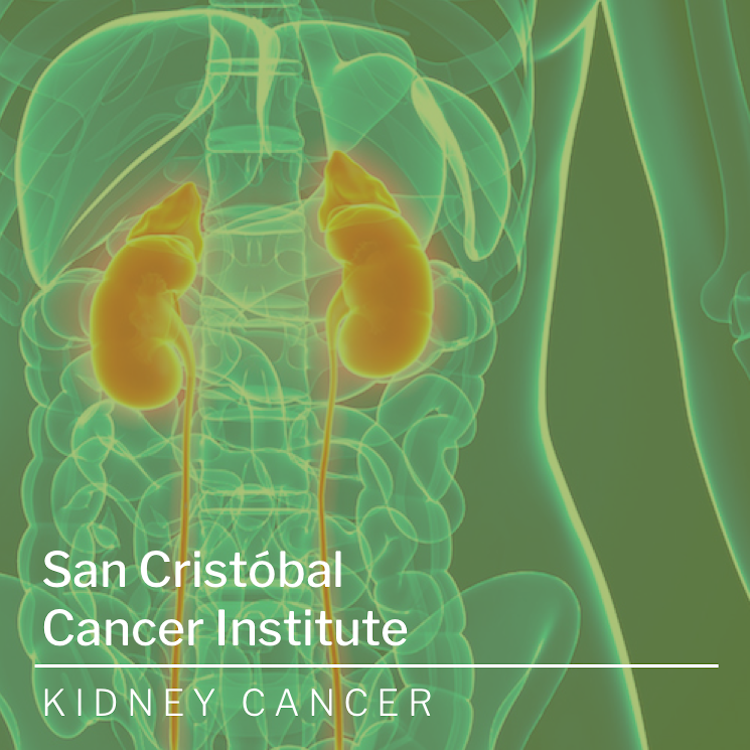
Kidney Cancer Facts

This year, an estimated 65,000 adults in the United States will be diagnosed with kidney cancer. Kidney cancer is the sixth most common cancer for men, and it is the tenth most common cancer for women. The disease is rarely found in people younger than 45 and the average age of diagnosis is 64. Out of these cases, it is estimated that almost 15,000 patients will die from it, and it’s the tenth most common cause of death for men. Although it is likely to survive kidney cancer through the extraction of one of the two organs, a rigorous prevention regimen is important to protect against cancer at all times.
Overview
In adults, renal cell carcinoma is the most common type of kidney cancer — about 90 percent of cancerous tumors. Other less common types of kidney cancer can occur. Young children are more likely to develop a kind of kidney cancer called Wilms’ tumor. The incidence of kidney cancer seems to be increasing. One reason for this may be the fact that imaging techniques such as computerized tomography (CT) scans are being used more often. These tests may lead to the accidental discovery of more kidney cancers. In many cases, kidney cancer is found at an early stage, when the tumors are small and confined to the kidney, making them easier to treat.
Types
There are several types of kidney cancer:
- Renal cell carcinoma. Renal cell carcinoma is the most common type of adult kidney cancer, making up about 85% of diagnoses. This type of cancer develops in the proximal renal tubules that make up the kidney’s filtration system. There are thousands of these tiny filtration units in each kidney. The treatment options for renal cell carcinoma are discussed later in this guide.
- Urothelial carcinoma. This is also called transitional cell carcinoma. It accounts for 10% to 15% of the kidney cancers diagnosed in adults. Urothelial carcinoma begins in the area of the kidney where urine collects before moving to the bladder, called the renal pelvis. This type of kidney cancer is treated like bladder cancer because both types of cancer start in the same cells.
- Sarcoma. Sarcoma of the kidney is rare. This type of cancer develops in the soft tissue of the kidney; the thin layer of connective tissue surrounding the kidney called the capsule; or surrounding fat. Sarcoma of the kidney is usually treated with surgery. However, sarcoma commonly comes back in the kidney area or spreads to other parts of the body. More surgery or chemotherapy may be recommended after the first surgery.
- Wilms tumor. Wilms tumor is most common in children and is treated differently from kidney cancer in adults. This type of tumor is more likely to be successfully treated with radiation therapy and chemotherapy than the other types of kidney cancer when combined with surgery. This has resulted in a different approach to treatment.
- Lymphoma. Lymphoma can enlarge both kidneys and is associated with enlarged lymph nodes, called lymphadenopathy, in other parts of the body, including the neck, chest, and abdominal cavity. In rare cases, kidney lymphoma can appear as a lone tumor mass in the kidney and may include enlarged regional lymph nodes. If lymphoma is a possibility, your doctor may perform a biopsy and recommend chemotherapy instead of surgery.
Symptoms
Kidney cancer rarely causes signs or symptoms in its early stages. And currently there are no routine tests used to screen for kidney cancer in the absence of symptoms. In the later stages, kidney cancer signs and symptoms may include:
- Blood in your urine, which may appear pink, red or cola colored
- Pain in your back or side that doesn’t go away
- Loss of appetite
- Unexplained weight loss
- Tiredness
- Fever, which usually comes and goes (intermittent)
Diagnosis
Tests and procedures used to diagnose kidney cancer include:
- Blood and urine tests. Tests of your blood and your urine may give your doctor clues about what’s causing your signs and symptoms.
- Imaging tests. Imaging tests allow your doctor to visualize a kidney tumor or abnormality. Imaging tests might include an ultrasound, a computerized tomography (CT) scan or magnetic resonance imaging (MRI).
- Removing a sample of kidney tissue (biopsy).In rare cases, your doctor may recommend a procedure to remove a small sample of cells (biopsy) from a suspicious area of your kidney. The sample is tested in a lab to look for signs of cancer.
Stages
Once your doctor identifies a kidney lesion that might be kidney cancer, the next step is to determine the extent (stage) of the cancer. Staging tests for kidney cancer may include additional CT scans or other imaging tests your doctor feels are appropriate. Then your doctor assigns a number, called a stage, to your cancer. Kidney cancer stages include:
- Stage I. At this stage, the tumor can be up to 2 3/4 inches (7 centimeters) in diameter. The tumor is confined to the kidney.
- Stage II. A stage II kidney cancer is larger than a stage I tumor, but it’s still confined to the kidney.
- Stage III. At this stage, the tumor extends beyond the kidney to the surrounding tissue and may also have spread to nearby lymph nodes.
- Stage IV. Cancer spreads outside the kidney, to multiple lymph nodes or to distant parts of the body, such as the bones, liver or lungs.
Treatment
Together, you and your treatment team can discuss your kidney cancer treatment options. The best approach for you may depend on a number of factors, including your general health, the kind of kidney cancer you have, whether the cancer has spread and your preferences for treatment.
Surgery: Surgery is the main treatment for the majority of kidney cancers, with the goal of removing the tumor and preserving normal kidney function. Surgical procedures used to treat kidney cancer may include:
- Removing the affected kidney (nephrectomy). A complete (radical) nephrectomy involves removing the entire kidney, a border of healthy tissue and occasionally additional nearby tissues such as the lymph nodes, adrenal gland or other structures. The surgeon may perform a nephrectomy through a single incision in the abdomen or side (open nephrectomy) or through a series of small incisions in the abdomen (laparoscopic or robotic-assisted laparoscopic nephrectomy).
- Removing the tumor from the kidney (partial nephrectomy). Also called kidney-sparing or nephron-sparing surgery, the surgeon removes the tumor and a small margin of healthy tissue that surrounds it rather than the entire kidney. It can be done as an open procedure, or laparoscopically or with robotic assistance. Kidney-sparing surgery is a common treatment for small kidney cancers and it may be an option if you have only one kidney. When possible, kidney-sparing surgery is generally preferred over a complete nephrectomy to preserve kidney function and reduce the risk of later complications, such as kidney disease and the need for dialysis.
The type of surgery your doctor recommends will be based on your cancer and its stage, as well as your health. Surgery carries a risk of bleeding and infection. When the cancer is confined to the kidney, surgery is usually the only treatment needed — no drugs or radiation are necessary.
Nonsurgical treatments: For some people, alternative options are available to destroy small tumors without surgery. These options include:
- Treatment to freeze cancer cells (cryoablation). During cryoablation, a special hollow needle is inserted through your skin and into the kidney tumor using ultrasound or other image guidance. Cold gas in the needle is used to cool down or freeze the cancer cells.
- Treatment to heat cancer cells (radiofrequency ablation). During radiofrequency ablation, a special probe is inserted through your skin and into the kidney tumor using ultrasound or other imaging to guide placement of the probe. An electrical current is run through the needle and into the cancer cells, causing the cells to heat up or burn.
These procedures may have advantages for certain patients and are a potential option for people who can’t have other surgical procedures and those with small kidney tumors.
Treatments for advanced and recurrent kidney cancer: Kidney cancer that recurs and kidney cancer that spreads to other parts of the body may not be curable, but may be controlled with treatment. In these situations, treatments may include:
- Surgery to remove as much of the kidney tumor as possible. Even when surgery can’t remove all of your cancer, in some cases it may be helpful to remove as much of the cancer as possible. Surgery may also be used to remove cancer that has spread to another area of the body.
- Drugs that use your immune system to fight cancer (biological therapy).Biological therapy (immunotherapy) uses your body’s immune system to fight cancer. Drugs in this category include interferon and aldesleukin (Proleukin), which are synthetic versions of chemicals made in your body. Nivolumab (Opdivo) is an immunotherapy sometimes used to treat advanced renal cell carcinoma.
- Targeted therapy. Targeted treatments block specific abnormal signals present in kidney cancer cells that allow them to multiply. These drugs show promise in treating kidney cancer that has spread to other areas of the body. The targeted drugs cabozantinib (CaboMetyx), axitinib (Inlyta), bevacizumab (Avastin), pazopanib (Votrient), sorafenib (Nexavar) and sunitinib (Sutent) block signals that play a role in the growth of blood vessels that nourish cancer cells and allow them to spread. Temsirolimus (Torisel) and everolimus (Afinitor) are targeted drugs that block a signal that allows cancer cells to grow and survive. Researchers continue to study how patients with specific genes might respond to certain targeted therapies.
- Radiation therapy. Radiation therapy uses high-powered energy beams, such as X-rays, to kill cancer cells. Radiation therapy is sometimes used to control or reduce symptoms of kidney cancer that has spread to other areas of the body, such as the bones and brain.
Be sure to thoroughly discuss with your doctor the benefits, risks and possible side effects of any treatment that you’re considering.
Resources
San Cristobal Cancer Institute offers a wide array of options to help our patients feel calm and supported during the process of screening, diagnosis and treatment, as well as getting back to life after cancer. Browse our alternatives for patients – including financial aid for those eligible – in our Patient Resources section.
If you’d like to learn more about Kidney Cancer through our San Cristóbal Education Resources, attend our events or learn about our Cancer Center, please contact us.
Knowledge is Power.
Education is one of our strongest tools at San Cristóbal Cancer Institute, empowering patients and their families with complete and updated information about more than a dozen types of cancer and providing first-hand knowledge through our dedicated team of cancer experts. If you’d like to know more, please get in touch with us. We look forward to offering you and your family powerful cancer awareness and the most comprehensive care.
